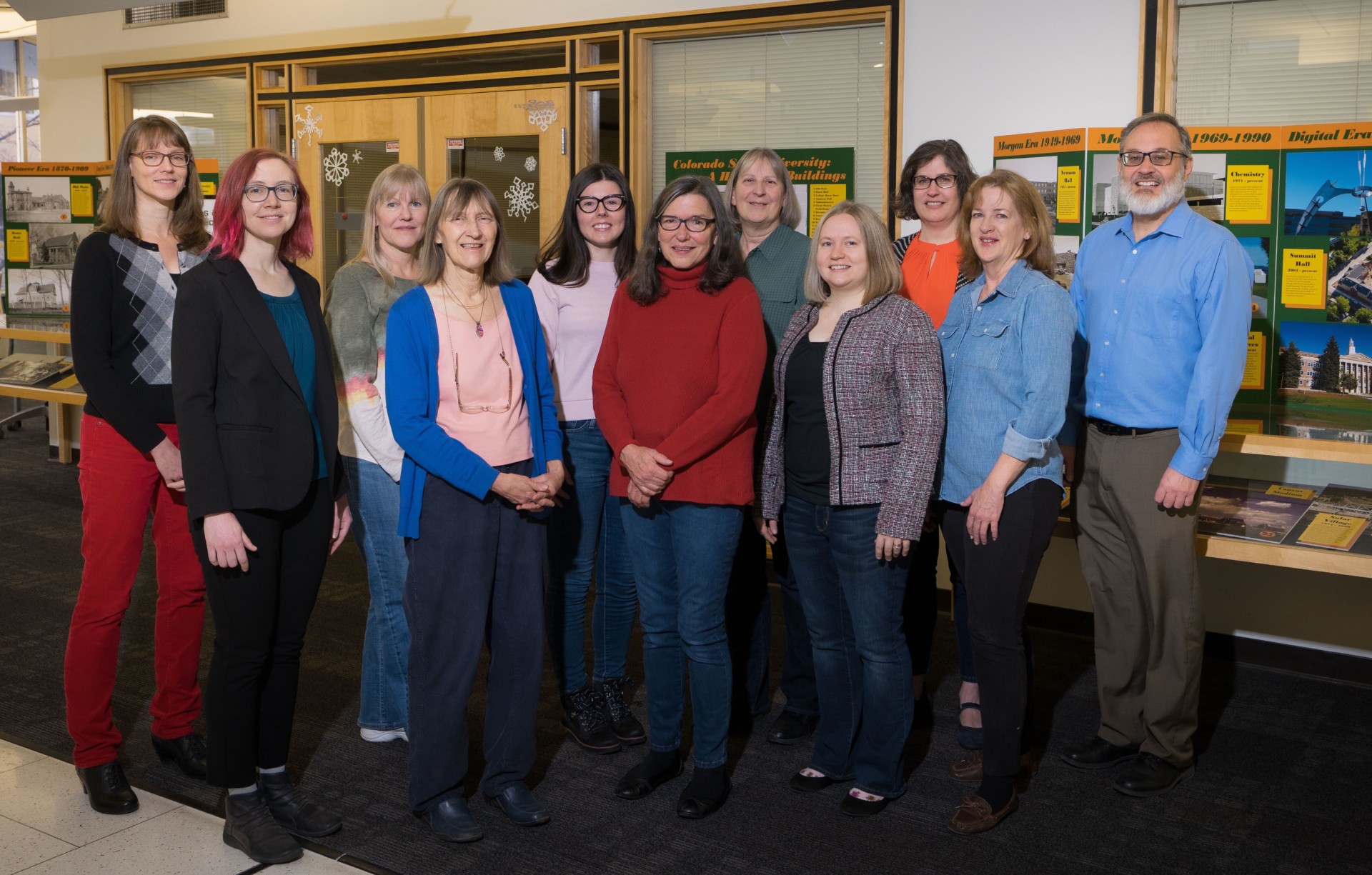
CSU Libraries Digital and Archives Service staff includes, front row, left to right, Mara Sedlins, Debbie McClelland, Vicky Lopez-Terrill, Clarissa Trapp, Ann Schwalm, Mark Shelstad; back row: Patty Rettig, Alicia Conrardy, Trista Barker, Linda Meyer, Helen Baer. Not pictured: Yongli Zhou. Photo by Joe Mendoza, CSU Photography
Colorado State University’s year-long look back over 150 years of serving the land-grant mission would not be possible without the dedicated staff of the Library’s Digital and Archive Services.
Behind a secure door on the second floor of Morgan Library, the staff works diligently to collect, evaluate, organize, preserve and provide access to historical information about the University, and research materials about Colorado water and agriculture. From some of the earliest hand drawn construction plans for the original Camp Collins to preserving websites devoted to the legalization of cannabis, CSU library archive staff have found a place for everything – most of it literally irreplaceable – and are always in need of more space, both physical and digital.
Collections in the archives concentrate heavily on the agricultural, natural resources and water issues that have shaped the history of Colorado, but there are also special collections devoted to wildlife photography, materials from feminist presses in the 1970s, the craft brewing industry, and a searchable database of images from the Colorado International Invitational Poster Exhibition, the only one of its kind in North America.
Humble beginnings
The present-day University Archives owes its existence to two very happy accidents. First, when CSU’s centennial was approaching in 1970, the administration thought it would be a great thing to write a history of the institution to mark the occasion – and that’s when James Hansen, then a newly hired professor of history, discovered there was no formal archives for the University. To write the history of the first hundred years – Democracy’s College, which became the first of three volumes – he began by gathering and organizing the materials he could find. From that effort, the University Archives was born.
The second fortunate event was the timing of a generous gift to the Archives in the 1990s. As the research project evolved and professional archivists took on the task of maintaining the collections, the materials outgrew their original space in the basement of the library. With donor support, space on the second floor of Morgan was remodeled to accommodate the Archives, and staff had just moved everything there two weeks before the devastating flood of 1997 inundated the first two floors of the building – which remains one of the worse disasters in U.S. history to strike an academic library.
The staff of the Archives take their mission to ensure collections are available for present and future researchers to use very seriously. In the 21st century, that means using some of the latest technology to preserve items in danger of succumbing to the ravages of time, whether they are hand-written diaries from the early 1900s, footage on silver nitrate film that grows increasingly unstable with age, and now providing data preservation and archiving services to CSU faculty and researchers.
Digitization needs
As part of the University’s fundraising campaign, State Your Purpose, CSU Libraries established a fund to support digitization of films from the earliest days of the University that will also form the basis of a documentary celebrating the University’s sesquicentennial; you can give to this fund at the Beyond a Billion website.
You can also support the ongoing needs of Digital and Archive Services at the general Library giving page.
To learn more about research data, digital archival collections, and rare treasures held by the Library’s Digital and Archive Services, contact Coordinator Mark Shelstad at mark.shelstad@colostate.edu.